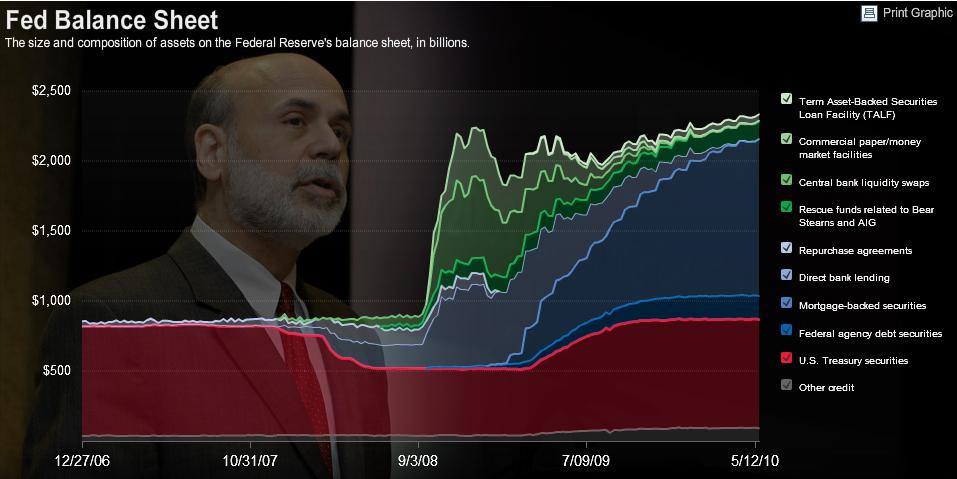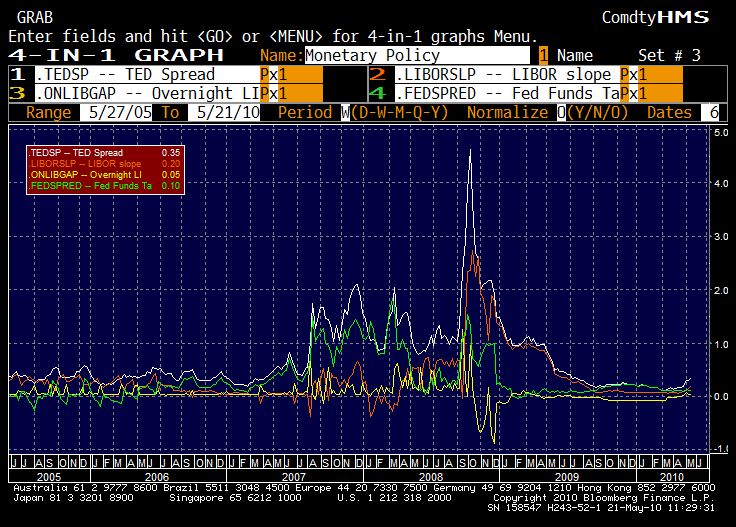
The image above is borrowed from this blog post at The Wall Street Journal.? Here’s my main point: the Fed is not succeeding in reducing the size of their balance sheet.? They are happily letting it grow, buying more mortgage backed securities, more than are paying off or defaulting.?? The Fed’s balance sheet is now at a record size.
I have argued in the past that the Fed is not likely to remove stimulus prematurely.? We have the bad providence that Ben Bernanke is Fed Chairman, and has the wrong view of the Great Depression, and also the wrong view of monetary policy.? He will leave rates low for too long, and buy long duration assets for the Fed, and be reluctant to sell them.
In absence of a commodity standard (which would be a very good thing), monetary policy should act to preempt high growth in debt.? If debt across the economy is growing at more than twice GDP growth rates that is a time to raise rates, and make it hard to borrow.? I realize at a time like now, this makes no sense, but had we adopted it in the 70s or 80s we would not have the present crisis.
In a fiat money/credit world, evil as it is, monetary policy is credit policy.? The issues become clear at the bust, but the prescriptions work best before the boom starts.
The Fed always delays trouble in the modern era.? Slow to tighten, quick to loosen.? No wonder that we built up a mountain of debt, because the Fed would always ride to the rescue of crises, but never let the pain settle in that would liquidate poor investments.
We need fewer banks, fewer homebuilders, and fewer auto companies.? But guess what we bailed out?? We bailed out the very things that were the least productive in our economy, and taxed those more productive to do so.? Monstrously dumb.
So when the market corrects because there has been no effective change in economic policy that would allow for elimination of bad debts, and shrinkage of bloated industries, we should not be surprised.? Government stimulus can only do so much.? The markets incorporate the stimulus, and they move on.? Those stimulated gain, and taxpayers/moneyholders lose, but the markets move on.
In the two-dimensional Fed where they offer credit to banks, and buy long assets as well, the Fed can’t be considered to be tight when the Fed funds rate is under 1/4%, and they are still sucking in long duration paper.? The Fed is engaged in an operation to support asset prices, which may fail when goods prices begin to show some life, regardless of whether the CPI agrees or not.
Monetary policy needs an anchor like gold, and people need to stop looking to the government for prosperity; the government can do little to achieve prosperity, aside from laying down a consistent set of rules.? Prosperity is in the hands of the culture, and productive cultures that take on little debt will tend to be prosperous.
And Now For Something Slightly Different
While I’m on the topic of monetary policy, what if the money markets are beginning to run ahead of the Fed?? Look at this:

There are 3 components to the Treasury-Eurodollar [TED] spread:
- The orange line is the LIBOR slope: 3 month US Dollar [USD] LIBOR minus overnight USD LIBOR.? LIBOR is a rate that banks will supposedly lend to each other at unsecured for short amounts of time.? As the LIBOR slope gets higher, banks are less willing to lend to each other.
- The yellow line is the Overnight LIBOR gap: it is overnight USD LIBOR minus the Fed funds target.? This measures how much banks need overnight money through sources outside of Fed Funds.
- The green line is called the Fed spread: it is the Fed funds target minus 3 month T-bills.? It measures how tight Fed policy is versus the ability of the US government to fund itself on the short end.
Now the current move is small, so far.? Banks are showing slightly more need for funding versus Fed funds, and since the crisis in the Eurozone intensified, the costs of borrowing longer in the Eurodollar market have risen.? But there isn’t the grab for safety, when T-bills go to zero, at least, not yet.? And contrast the last year with the last five years:

Panics aren’t pretty. They also start small.? I’m not saying that this must turn into a money markets panic, but only that it is possible.? There is a budding distrust in the Eurodollar lending markets, and that could spill into the short term lending markets in the US, though the effect should be less than in the Eurozone, where distrust is building across national borders.? Many banks implicitly say, “Better to have assurance regarding getting our money back if we need it, than be at the mercy of another nation’s laws.? Who knows if this grand experiment of the EU and the Euro will really last?”
Two Experiments
The Euro is an experiment, but so is unbacked paper money.? Both are undergoing a lot of stress at present; it will be interesting to see if either survives.

@DM: scary charts to be sure.
Fiat money vs gold backed vs other
I realize gold is the traditional standard to “fix” (e.g., stabilize) fiat money. It may have been quite appropriate when hand shovels and wooden sluices were in vogue. Is it really the best we can do in an era of moving tons of dirt with mechanical monsters to uncover ounces of gold?
What not something far more stable? Say an index of land mass x population vs GDP to determine an appropriate money supply. Since land mass doesn’t change much the money supply then would mimic population growth.
David,
I’d really like to hear your perspective on deflation. Like you, I’ve been worried about our monetary course leading to inflation, but many roads are pointing to the opposite — falling consumer prices, excess capacity everwhere, falling commodity prices, and incipient tax hikes and (European) austerity, both of which are additionally contractionary and deflationary. Of course, deflation just adds to our debt woes. Are we in a liquidity trap?
scm, personally I think deflation is more likely than inflation, though I don’t rule anything out. The Great Depression was not an aberration; nor is the Japan disease now. Policymakers tend to protect the system, until there is no more system to protect, and we face a sovereign default/deflation or severe inflation. It depends on the actions of policymakers, which will not be known for some time. This is a slow motion train wreck.
You’re making too many unsupported assertions here.
If Bernanke’s view of the Great Depression is wrong (I assume you mean that he belives that monetary policy was to blame), then what is the better view? I don’t know if you’ve read Sumner on this, but he’s argued that he fed has, indeed, been very tight at key moments during this crisis.
What problem would a commodity standard solve? How exactly does it prevent a mountain of debt piling up?
You seem to be an inflation hawk and really into the idea of the recession being in the real economy (misallocated resources), but I really don’t see how your suggestions would work to either solve or prevent these problems. More detail, please.
DW, I admit there are unsupported assertions in this article, but I have supported those assertions in other posts at my blog. Not every post can be self-complete. Next time I will try to put in more links.
What are the key money market indicators in the Euro zone? Can you run the same graphs there? I suspect to a small degree what you are showing is just the quake zone is not in the US at the moment.
You’re probably right, and I will play around with it. If I get something good, I will post.
You … are an idiot.
All of your concerns have already been addressed in Kansas City Fed papers … If you had the intelligence to read them.
Try thinking in a differential manner, than in stupid linear models that have been proven so wrong, for so long, no serious mathematician has followed them for 60 years.
Christopher, if I am an idiot, put some more meat on the bones of your arguments. I’m not afraid of feedback, especially not now as the Keynesian errors of 80 years are getting close to their rejection point.